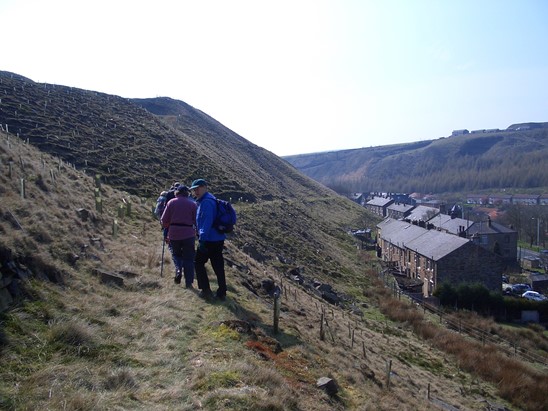Two quarries just east of the A671 at Millgate, on the edge of Shawforth, have been recently landscaped. However, some remnant quarry faces, at a relatively low elevation, have better accessibility for users with low mobility.
Historical Summary
Working Life: Opened post 1829. Disused just after 1938.
Geology: Upper Haslingden Flag wtih rough rock to the east.
.jpg)
Methods: Open pit and mine
Transport: Included a tramway leading south to Leavengreave. Newspaper reports of accidents frequently mention horse-drawn carts (Davies 1985 - 1986).

Historical Summary
Moss Quarry comprises a large area of hillside outcropping and underground mining in the Upper Haslingden Flagstones Some of the faces are in the coarser Rough Rock and this may have been used for aggregate. A series of working faces run along the east side of the site with extensive spoil heaps to the west, although these have been degraded by motorbike scrambling, other activities and recent tree planting. The quarry may be approached by trackways from the north and south: in part these follow the route of the short tramway to a set at Levengreave. The quarry has a strong scatter of associated features including the foundations of quarrymen’s shelters, earthwork platforms (possible processing areas), several small roofed buildings, and crane bases.
Nearby Landgate Quarry is heavily landscaped, but was formerly a large clay pit in the Lower Coal Measures excavated for gannister clay (fire clay) below the associated Lower Mountain Mine. Only a residual east face survives.
History:
1829 the new Lord of the Manor of Rochdale James Dearden started Moss Quarry, and by 1843 local farmer John Turner was head man.
1869 John Turner took a lease to actually run the quarry and in 1871 employed 30 men.
1870s stone mining began (in 1880 16 underground workers).
1889 a mineral tramway was constructed from the quarries to a roadside set at Leavengreave.
Around 1900 Brooks and Brooks took over.
By 1923, Bower & Son Ltd were running the quarry at a reduced scale. Only 5 workers remained in 1938, and quarrying ended soon after
Landgate Quarry
Ganister clay (fire clay) was extracted in the 1960s, from a thick 1 metre layer below the Lower mountain Mine coal seam. The clay was processed in Darwen to create sanitary pipes and related products. These excavations on common land, and subsequent tipping of rubble and thousands of tyres, were a serious eyesore for many years, some of the worst dereliction in Lancashire. By 2004 Lancashire County Council successfully landscaped the site and have fenced areas for vegetation regrowth and tree planting.
